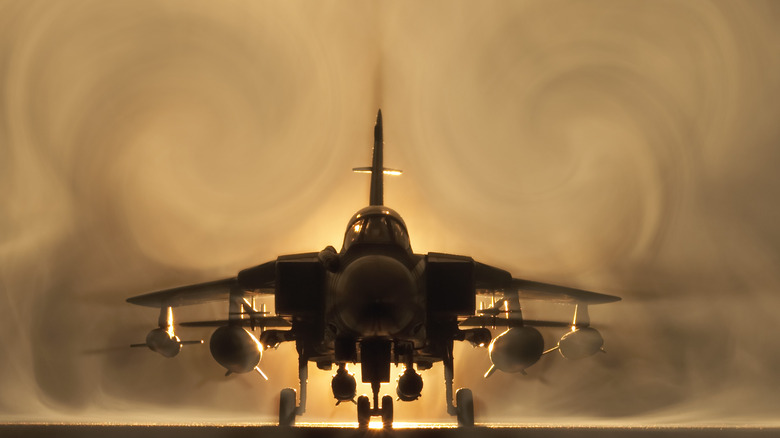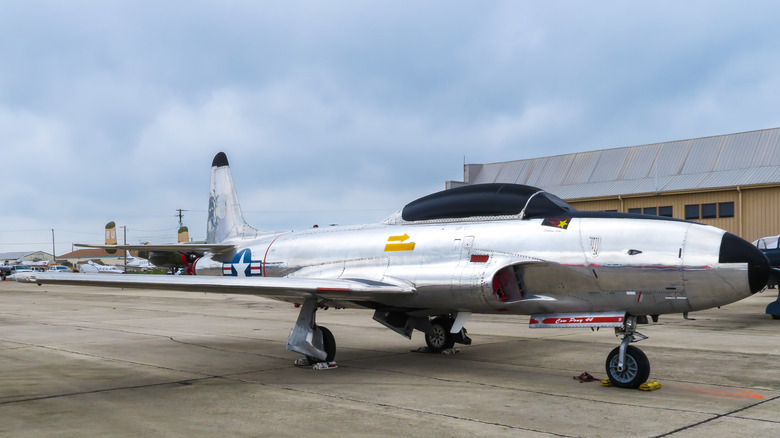5 Of The Best-Looking Fighter Jets In Military History
Aviation has been a critical element in warfare since World War I, which broke out just as airplanes were arriving as mainstream technology. In the years since then, military airplanes have evolved from open-cockpit rattletraps to multi-million dollar high-tech machines with advanced weapons, navigation, and detection avoidance systems. Fighter jets first took to the skies during World War II, and planes from that era include the pioneering Messerschmitt ME-262 and the Lockheed F-80.
While the emphasis in fighter jet development has been primarily to make them agile in the air and effective battle machines, there's no denying the visual appeal of a sleek jet that is built to go faster than the speed of sound and look tough at the same time. We've taken some time to go through the pages of military aviation history in an effort to single out what we felt were the best-looking fighter jets ever. Although we selected the following five aircraft solely based on their outward appearance, we discovered that many of them brought to the skies some important technological innovations to go along with their striking good looks.
The F-14 Tomcat starred in Top Gun
The United States Navy has been operating F-14 Tomcat fighter jets in combat since the 1980s, and these planes have seen action all around the world. Grumman began developing the F-14 in the early 1970s after the General Dynamics F111-B was found to be too heavy to use on aircraft carriers. The F-14 took its first flight at the end of 1970, and the Navy took delivery of its first one a year and a half later. It didn't see combat until 1981 but remained on active duty for the United States for a quarter century, with the last one being retired in 2006. The F-14 Tomcat looks like a not-so-distant cousin of the fighters used by the Rebel Alliance in the "Star Wars" films and starred in a two-film franchise that debuted about a decade after "A New Hope."
The F-14 was featured prominently in the 1986 blockbuster action film "Top Gun" and in a smaller role in the 2022 sequel, "Top Gun: Maverick." Paramount paid about $8,000 an hour (equivalent to more than $23,000 today) to keep the fighters in the sky for the original film, but by the time the sequel was in production, all of the U.S.-based F-14s had been grounded. There were still some in service in Iran, but filmmakers couldn't secure access to them. One without an engine was used for a scene that takes place in a hangar, and computer graphics were used to generate F-14s for flight sequences.
The MiG-29 is one of Russia's coolest jets
The Cold War between the United States and the Union of Soviet Socialist Republics (U.S.S.R.) was in full swing when the Soviets began working on the MiG-29 in the late 1960s. The country needed a replacement for the MiG 21, which had been in service since the beginning of the decade. The MiG acronym is a combination of the beginning letters of Mikoyan and Gurevich — the two manufacturers — joined with an i, which means "and" in Russian. A prototype took to the air in 1977, and the production version followed five years later. The MiG-29 looks like a combination of a Space Shuttle and a Bonneville Salt Flats speed machine, with large twin afterburners and massive vertical fins that give it stability and an imposing profile.
The U.S.S.R built an export version for more than two dozen of its allies, but the fighters it sent abroad weren't capable of carrying out nuclear attacks. When the country split into its individual states at the end of 1991, 34 nuclear-capable MiG-29s became the property of the Republic of Moldova. The United States bought 21 of them in 1997, presumably to keep them out of the hands of rogue nations. Many were dismantled after a good going-over, but a few are on display in various spots around the country. The Pima Air and Space Museum in Tuscon, Arizona, has one on loan from the U.S. Air Force, and another sits outdoors at Wright-Patterson Air Force base in Ohio.
Northrop F5
To portray the enemy's MiG 28s in "Top Gun," producers secured some Northrop F-5 fighters and painted them black. While they are similar enough in appearance to allow this bit of movie magic, we chose the F-5 over the MiG for this list mostly for patriotic reasons. It's also been more widely distributed around the world than its Soviet lookalike, meaning you have a better opportunity to catch an F-5 at an airshow near you.
The F-5 looks like something Evel Knievel would have used to jump school buses or a gorge in the 1970s but took its first flight in the Summer of 1963. The streamlined construction and 7:1 thrust-to-weight ratio provided by the General Electric J85-13 engines make the F-5 slick and fast. It looks like it's almost ready for space travel and can go 1.4 times the speed of sound and climb to 50,000 feet. That's almost nine and a half miles and puts the F-5 in the lower reaches of the stratosphere. It was in service for most of the Cold War, from 1964 through 1989.
The F-117 Nighthawk - the first stealth fighter
One of the most impressive-looking fighter jets to come out of the 20th century is the F-117 Nighthawk, which is the first stealth aircraft in history. Because it employed nascent stealth technology, the F-177 required a unique design, which made it look, in a word, cool. The F-117 was developed in the aftermath of the Vietnam War out of concern for the advanced technology present in the Soviet Union's missile defense systems.
The F-117 was revealed in the late 1980s, and because it required a reduced radar cross-section, the aircraft was designed with a faceted shape. It also lacked afterburners, so its heat exhaust was cooled with ambient air, reducing its infrared signature. Almost all of the design elements that contributed to the F-117's uniquely beautiful shape were deliberate choices to ensure it remained invisible to everything other than an observer's Mk. I eyeballs.
The F-117 was the result of a great deal of R&D, and they cost $42.6 million (nearly $150 million in 2024). Resulting in the production of only 59 aircraft. The F-117 was first used in combat during Operation Just Cause in Panama in 1989 and later in Operation Desert Storm and the Kosovo conflict in the late '90s. On March 27, 1999, an F-117 was lost, and another was damaged days later. In 2006, Congress mothballed the F-117 fleet, which was preserved in a manner that would enable future recall should they be needed, with plans for all to be demilitarized by 2034.
The P-80 Shooting Star - America's first jet fighter
While Germany beat the Americans in getting operational jet fighters in the air during World War II, it didn't take long for the U.S. to follow suit. The result was the P-80 Shooting Star, which went from design to deployment in a staggeringly short 143 days. Lockheed developed the P-80, introducing it in 1945, and despite being the first American fighter developed with jet engines, it was remarkably successful.
It featured incredibly smooth lines in a gorgeous symmetrical design, and while it was retired in the States by 1959, over 6,000 had been built. The P-80 saw limited action during WWII, having been thrust into the conflict shortly before it ended. After the war, the U.S. continued flying the fighter, using it extensively during the Korean War, where P-80s scored 75% of enemy kills during the conflict's opening months. The P-80 boasted a single Allison J33-A-35 centrifugal compressor turbojet, which enabled it to reach Mach 0.76 (583 mph), though its cruise speed was 437 mph.
Multiple variants were built over the years. One variant, the F-80C (redesignated F for Fighter as opposed to P for pursuit), had a range of 1,090 miles and a service ceiling of 46,800 feet. It was also well armed, with six .50 caliber M3 Browning machine guns, eight 127mm unguided rockets, or one ton of bombs. The F-80C wasn't merely the first successful production jet fighter; it was also the first American plane to sustain speeds in excess of 500 mph, and it was the first to engage in jet-on-jet combat, resulting in a win for pilot Lt. Russel Brown.





